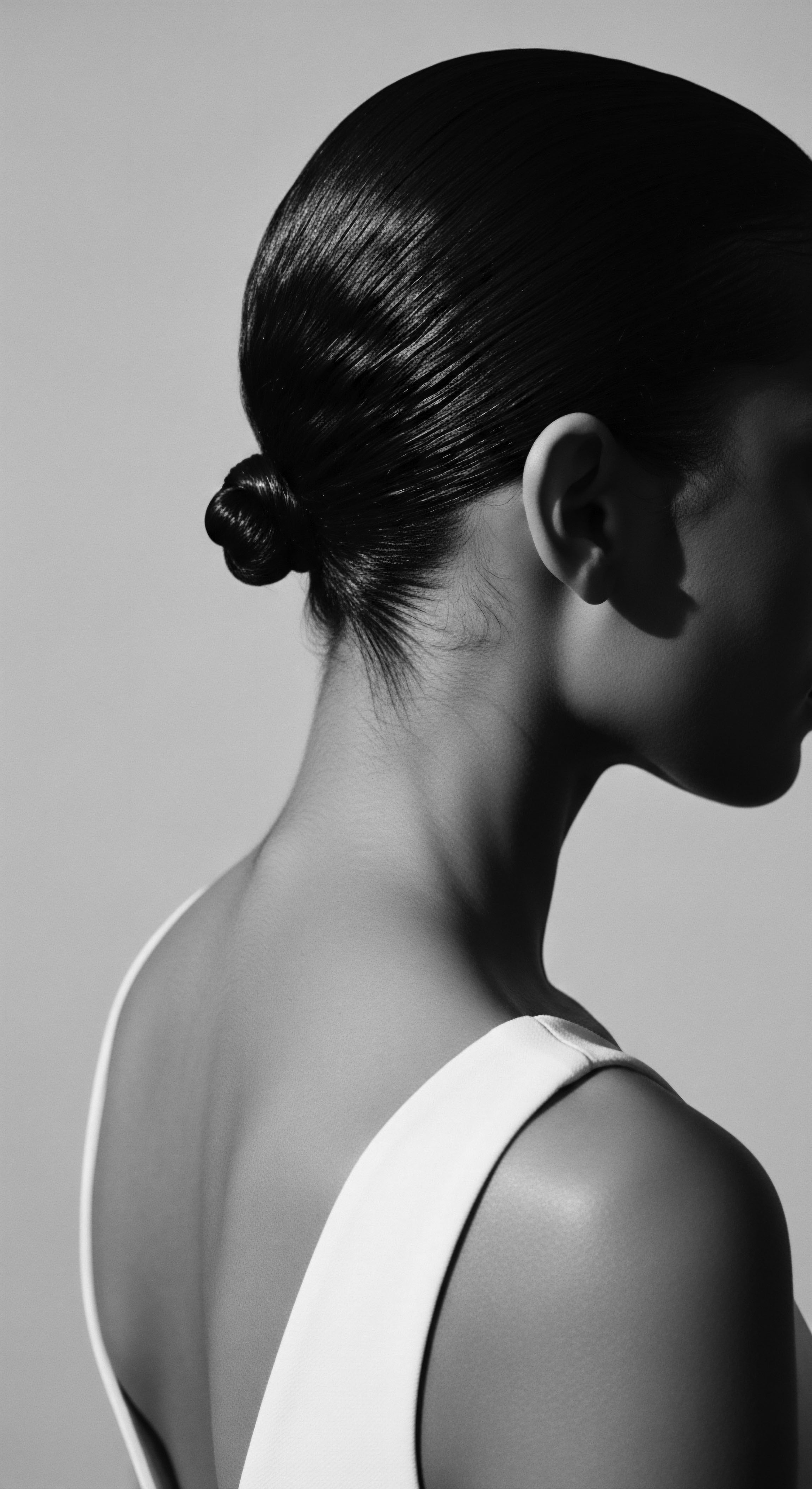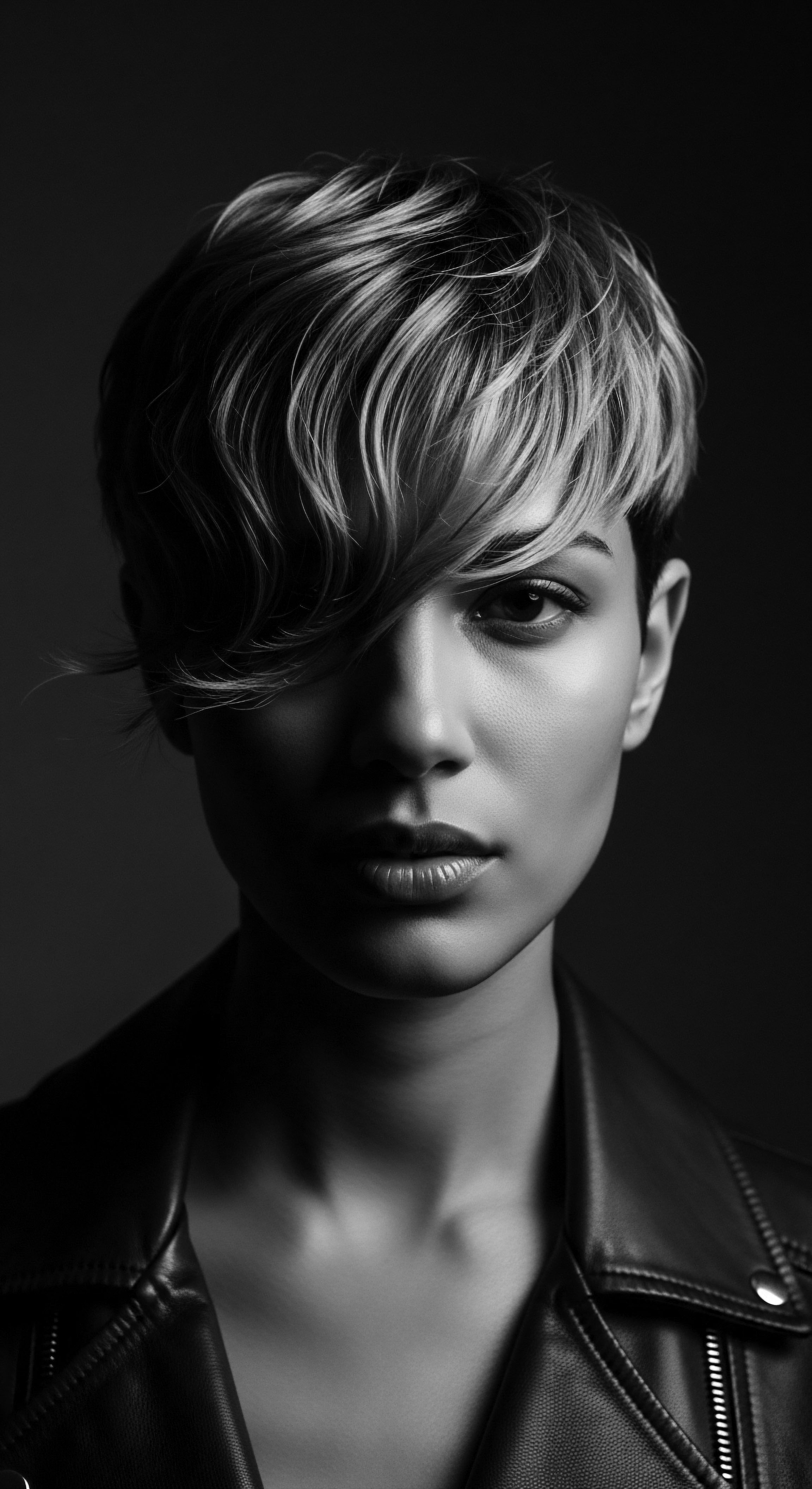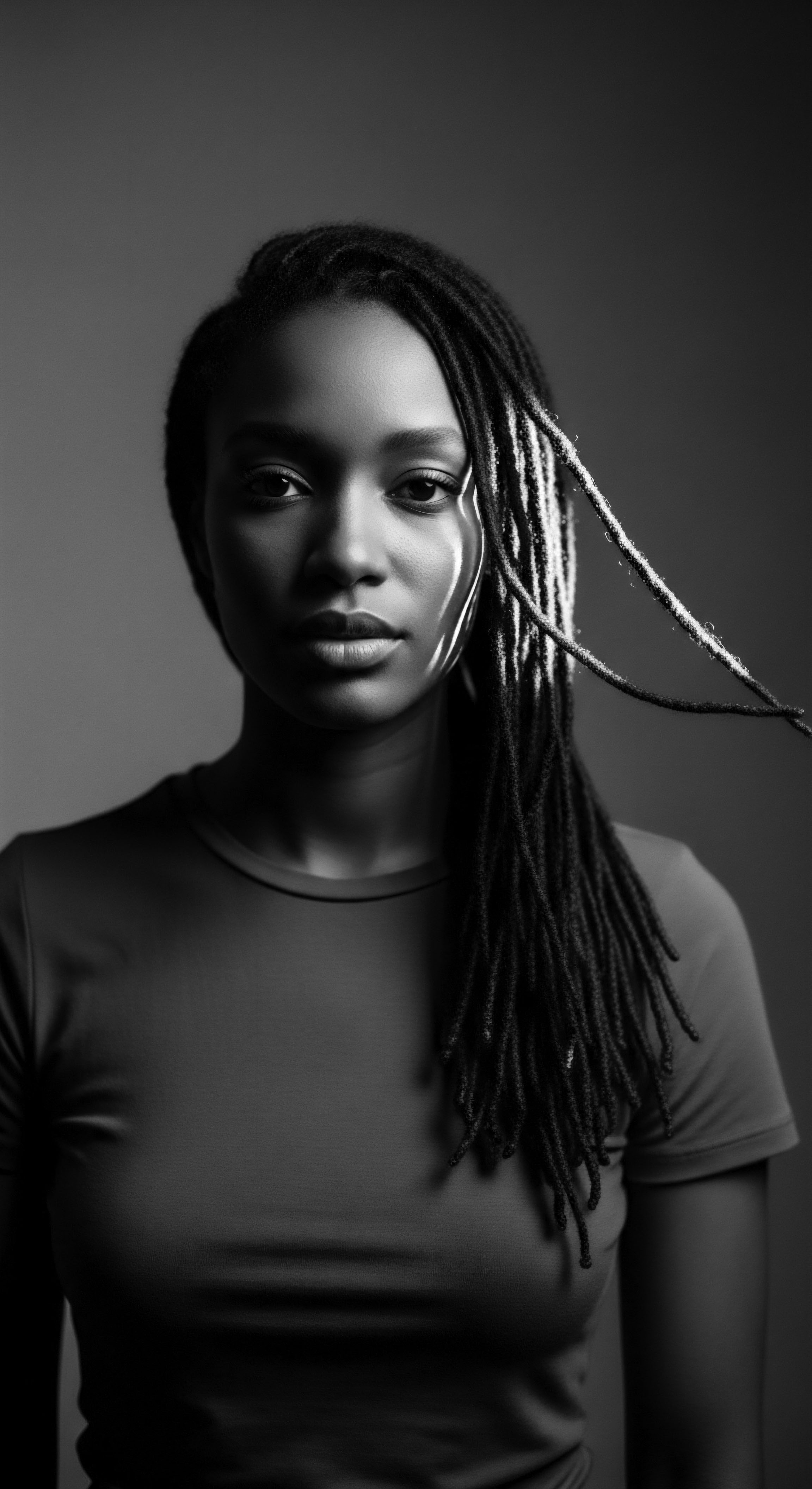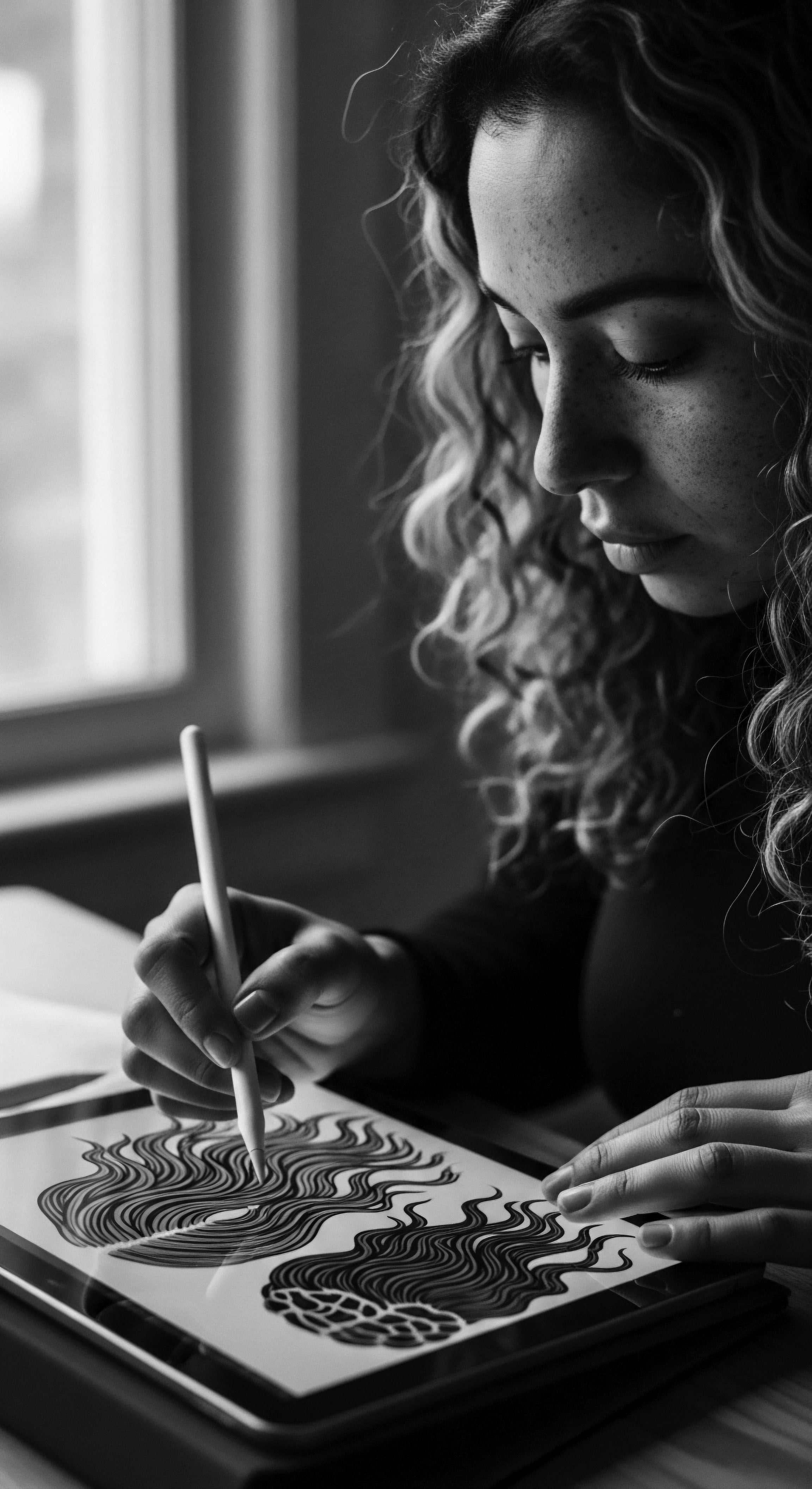
Roots
Consider, for a moment, the very strands that spring from the scalp, a living testament to journeys spanning epochs. For those of us whose hair coils, curls, or kinks with glorious determination, each fiber carries more than just genetic code; it holds echoes of a deep, unbroken lineage. Can the ancient wisdom held within traditional African ingredients truly speak to the complex requirements of textured hair today?
To pose this question is to embark upon a reverent exploration of our biological inheritance and the ancestral ingenuity that nurtured it. It is to acknowledge that before laboratories synthesized compounds, our forebears walked among botanicals, discerning their secrets, cultivating a profound understanding of what our hair truly yearned for.
The anatomy of textured hair, often an enigma in contemporary discussions, was, for generations, an open book to those who lived intimately with it. Unlike straighter hair types, the elliptical cross-section of a coily strand and its unique cuticle arrangement mean moisture struggles to navigate its spiraling path. This structural particularity renders textured hair more susceptible to dryness, demanding a continuous, mindful commitment to hydration.
Across the continent, from the sun-drenched savannas to the humid rainforests, communities observed these innate characteristics. They understood, with an intuitive certainty, that hair was not merely an adornment; it was a delicate, vital extension of self, requiring specific, loving attention.
This inherent biological disposition was met with an equally intuitive pharmacy of nature. The bountiful landscapes of Africa offered a rich palette of ingredients, each selected for its demonstrable capacity to fortify, soften, cleanse, and protect. These were not random selections; they represented centuries of accumulated wisdom, passed down through the gentle hands of mothers, aunties, and village elders. The nomenclature of textured hair care, in its deepest sense, begins with these traditional understandings—a lexicon woven from the properties of the earth itself.
The intricate biology of textured hair found its earliest, most potent allies in the abundant botanicals of Africa, a testament to ancestral observation and wisdom.

The Hair Follicle and Its Ancestral Connection
Every strand emerges from a follicle, a microscopic organ deeply anchored within the skin. For textured hair, this follicle often presents an asymmetrical opening, influencing the characteristic bend and coil of the hair shaft as it grows. This inherent curvature means the scalp’s natural oils, sebum, find it challenging to travel down the entire length of the strand, leaving the ends particularly vulnerable.
Ancestral practices, driven by necessity and observation, frequently centered on scalp health and the deliberate application of emollients to compensate for this natural distribution challenge. Think of the meticulous oiling rituals, often performed with a sense of communal purpose, designed to nourish both the scalp and the thirsty hair shaft.

How Did Traditional Practices Interpret Hair Growth?
While modern science delineates anagen, catagen, and telogen phases with precision, ancient cultures understood hair growth as a continuous cycle, tied to life’s rhythms and the seasons. They recognized periods of vibrancy and periods of shedding. Their remedies and rituals, therefore, supported the hair throughout its lifespan.
Ingredients rich in vitamins, minerals, and antioxidants were intuitively chosen, not for their scientific classification, but for their observed ability to maintain a robust, healthy cycle. For instance, the traditional use of certain plant extracts, known today for their anti-inflammatory properties, would have supported a healthy scalp environment, a crucial factor in optimal hair growth.
- Shea Butter ❉ A fatty oil derived from the nuts of the African shea tree, revered for its emollient properties and ability to seal moisture within the hair shaft, shielding it from environmental stressors.
- Baobab Oil ❉ Extracted from the seeds of the majestic baobab tree, this oil is a light yet potent moisturizer, rich in omega fatty acids, traditionally used to impart softness and elasticity.
- African Black Soap ❉ A cleansing agent crafted from the ash of plantain skins, cocoa pods, and palm tree leaves, offering a gentle yet effective purification of the scalp and hair, respecting natural moisture levels.

Ritual
To speak of traditional African ingredients is to speak not merely of botanical substances, but of the very rituals that brought them to life, the tender threads that connect hands across generations. Care for textured hair was, and remains, a practice woven into the fabric of daily existence, communal identity, and spiritual connection. It was within these practices that the efficacy of each leaf, root, and seed was tested, refined, and passed down. Modern textured hair needs often revolve around managing dryness, breakage, and maintaining defined patterns; these are precisely the concerns that ancestral rituals addressed with remarkable foresight and efficacy.
The tradition of protective styling, for instance, finds its deepest roots in African heritage. Styles like intricate braids, twists, and locs were not merely aesthetic choices; they served a vital purpose in guarding delicate strands from the elements, reducing manipulation, and promoting length retention. Ingredients like shea butter or various plant-based oils were applied during the styling process, providing lubrication, sheen, and a protective barrier against moisture loss. These practices show a sophisticated understanding of hair mechanics, long before terms like “low manipulation” entered the modern lexicon.
Ancient styling techniques, enriched by the purposeful application of African ingredients, offered both aesthetic grace and practical hair preservation, a wisdom centuries old.

The Sacred Act of Cleansing and Conditioning
The act of cleansing hair was rarely a harsh stripping; it was a gentle purification, often employing natural saponins from plants or mild clays. Think of the rhassoul clay from Morocco, known for its drawing properties, or the saponifying effects of certain plant barks used in West Africa. These natural cleansers would remove impurities without disrupting the hair’s delicate pH balance, a consideration that aligns perfectly with modern approaches advocating for sulfate-free and moisture-retaining shampoos.
Following this, conditioning was not an afterthought but an intrinsic step. Ingredients rich in mucilage, like aloe vera or hibiscus, provided slip for detangling and coated the hair with a hydrating film, addressing the primary need for moisture in textured strands.
Consider the meticulous process of applying a herbal rinse, perhaps made from a decoction of rosemary and nettle, to stimulate the scalp and impart shine. This was a patient, mindful act, often accompanied by storytelling or singing, grounding the individual within their community and history. The properties of these botanicals were known not from chemical analysis, but from generations of lived experience and observed outcomes.

What Role Did Oils Play in Ancestral Care?
Oils held a paramount position in ancestral hair care, applied for a multitude of purposes beyond simple lubrication. They were used to seal moisture into the hair after washing, to protect strands during styling, to massage the scalp for circulation, and even as a daily moisturizer to combat dryness. The choice of oil varied by region and local availability, from the light, penetrating baobab oil to the richer, deeply conditioning shea oil.
Each was understood for its distinct properties. For example, some oils might be favored for their ability to add sheen, while others were prized for their protective qualities against sun and dust.
| Traditional Ingredient Chebe Powder |
| Ancestral Usage (Heritage) Used by Basara Arab women in Chad for strength and length retention, often mixed with oils. |
| Modern Textured Hair Benefit Reinforces hair strands, reduces breakage, promotes length, and aids in moisture retention, particularly for coily and kinky textures. |
| Traditional Ingredient Marula Oil |
| Ancestral Usage (Heritage) Applied topically for skin and hair health across Southern Africa, prized for its emollient properties. |
| Modern Textured Hair Benefit Lightweight yet deeply moisturizing, rich in antioxidants and fatty acids, provides softness, reduces frizz, and adds a natural sheen. |
| Traditional Ingredient Kukui Nut Oil |
| Ancestral Usage (Heritage) Traditionally used in Hawaiian and Pacific Island cultures for dry skin and hair, known for its light texture and penetrating ability. |
| Modern Textured Hair Benefit Offers deep hydration without heaviness, helps to repair damaged hair, and soothes irritated scalps, making it suitable for fine textured strands. |
| Traditional Ingredient These ancestral ingredients demonstrate a continuum of care, their historical uses directly addressing contemporary textured hair challenges. |
- Moringa Oil ❉ A light, nutrient-dense oil, derived from the seeds of the moringa tree, valued for its ability to condition and fortify hair strands without weighing them down.
- Neem Oil ❉ Extracted from the neem tree, this oil possesses potent cleansing and clarifying properties, traditionally used for scalp ailments and to promote a healthy hair environment.
- Hibiscus Flowers ❉ Ground into a powder or steeped as a rinse, hibiscus aids in conditioning, promoting sheen, and supporting hair growth due to its mucilage content and natural acids.

Relay
The conversation around textured hair needs in the modern era, particularly within Black and mixed-race experiences, often cycles back to challenges of moisture, elasticity, and mitigating environmental damage. It is here, at the crossroads of scientific inquiry and ancestral memory, that the true genius of traditional African ingredients reveals itself. These ingredients, far from being mere folkloric curiosities, contain complex biochemical profiles that directly address the very needs identified by contemporary trichology. The relay of knowledge, from elder to child, from observation to practice, finds potent validation in today’s laboratories.
Consider the persistent quest for moisture in textured hair. The structural morphology of coiled and kinky hair, characterized by a higher number of disulfide bonds and an often-disrupted cuticle layer, makes it inherently prone to dehydration. Modern formulations often turn to synthetic humectants and emollients to combat this. Yet, traditional African ingredients offer a rich array of natural alternatives.
For example, the humectant properties of Honey, a long-revered ingredient across many African cultures, draw moisture from the air into the hair shaft. Similarly, the mucilaginous compounds in Okra, traditionally used as a natural detangler and conditioner, create a hydrating film that seals moisture without silicones.

Are Traditional Formulations Bio-Compatible?
The concept of bio-compatibility, a cornerstone of modern cosmetic science, finds a historical precedent in ancestral African hair practices. Traditional formulations were often simple, using a limited number of raw ingredients, minimizing the risk of irritation or sensitization. The skin, including the scalp, is a living organ, and these natural compounds, many of which share molecular structures with our own lipids and proteins, are often recognized and utilized efficiently by the body.
This contrasts with the sometimes overwhelming complexity of modern ingredient lists, where multiple synthetic compounds can interact in unforeseen ways. The ancestral approach favored synergy found in nature, allowing ingredients to work in concert, much like a well-composed botanical symphony.
A compelling historical example of this inherent bio-compatibility, and the ingenuity behind it, can be found in the traditional use of Chebe Powder by the Basara Arab women of Chad. This finely ground blend of Chebe seeds (Croton zambesicus), Mahlaba seeds (Prunus mahaleb), Missic stone, Clove, and Samour resin, when applied as a paste with oils, has been attributed to exceptional hair length and strength retention. A study by the Royal Society of Chemistry, while focusing on hair’s fundamental properties, implicitly supports the idea that treatments reducing friction and mechanical stress can prevent breakage in textured hair (Bhushan, 2010). Chebe’s traditional application, a cyclical process of moisturizing and protecting the hair shaft, effectively minimizes breakage, thereby promoting significant length retention in a hair type otherwise prone to fragility.
The powder acts as a physical shield, binding to the hair shaft and reducing the friction that leads to mechanical damage, a key factor in how textured hair often struggles to retain length despite its growth rate. This practice, deeply embedded in a specific cultural tradition, offers a powerful demonstration of how seemingly simple ancestral methods directly address a significant modern textured hair concern.
The scientific efficacy of traditional African ingredients for textured hair often stems from their natural bio-compatibility and synergistic properties, validating centuries of ancestral wisdom.

How Do Ancestral Remedies Combat Environmental Stressors?
Textured hair, due to its exposed cuticle, is particularly vulnerable to environmental aggressors such as UV radiation, pollution, and extreme humidity or dryness. Long before the advent of chemical sunscreens or anti-pollution serums, African communities intuitively understood the need for external protection. Ingredients like Red Palm Oil, with its rich carotene content, offered a natural shield against sun damage. Similarly, the liberal application of various plant-based butters and oils created a physical barrier, not only sealing in moisture but also preventing environmental particles from directly contacting the hair shaft.
This approach aligns with modern understanding of oxidative stress and barrier function. The antioxidants found in many traditional ingredients, such as Amla (though not exclusively African, its principles of use align) or the Vitamin E abundant in Argan Oil, counteract free radical damage. These are not merely superficial benefits; they contribute to the long-term health and resilience of the hair strand, a holistic view of well-being that spans generations.
The careful preparation of these ingredients, often involving slow infusion processes or gentle grinding, preserved their delicate compounds, ensuring their potency. This bespoke approach to hair care, tailored to individual and community needs, offers a powerful alternative to the mass-produced, one-size-fits-all solutions prevalent in much of the contemporary market. It invites a deeper engagement with the source of our remedies, fostering a connection to the land and the legacy that precedes us.
| Modern Textured Hair Need Hydration and Moisture Retention |
| Traditional African Solution (Ingredient/Practice) Aloe Vera (mucilage-rich sap), Honey (natural humectant), Baobab Oil (fatty acids, film-forming) |
| Scientific Principle/Effect Attracts and binds water, forms a protective barrier, reduces transepidermal water loss. |
| Modern Textured Hair Need Reducing Breakage and Strengthening Strands |
| Traditional African Solution (Ingredient/Practice) Chebe Powder (physical protection), Fenugreek (protein content, strengthens follicle), Rice Water (fermented starch for elasticity) |
| Scientific Principle/Effect Minimizes mechanical friction, provides amino acids for keratin structure, strengthens hair cortex, improves elasticity. |
| Modern Textured Hair Need Scalp Health and Circulation |
| Traditional African Solution (Ingredient/Practice) Neem Oil (antifungal, antibacterial), Ginger (stimulant), Rosemary (circulation booster) |
| Scientific Principle/Effect Combats microbial imbalances, stimulates blood flow to follicles, reduces inflammation, promoting a healthy environment for growth. |
| Modern Textured Hair Need The enduring effectiveness of these ancestral remedies reveals their profound alignment with the complex biological demands of textured hair. |
The modern textured hair landscape, with its array of scientific advancements, can greatly benefit from this dialogue with ancestral practices. By understanding the inherent properties of ingredients like shea butter, derived from the Vitellaria paradoxa tree, or moringa oil, extracted from Moringa oleifera seeds, we gain not only potent natural remedies but also a deeper appreciation for the wisdom encoded in cultural practices. These ingredients are not merely placeholders for synthetic compounds; they are active agents, often containing a spectrum of beneficial molecules—vitamins, minerals, antioxidants, and fatty acids—that work synergistically. The relay, then, is not just about adopting old ways; it is about re-interpreting, validating, and elevating them, ensuring their legacy thrives in the present and future.

Reflection
The journey through the very core of textured hair, its foundational biology, and the intricate care rituals of its heritage, brings us to a compelling realization. The question, “Can traditional African ingredients address modern textured hair needs?” does not merely seek a yes or no answer; it unfolds into a vibrant affirmation, a resounding echo from the past that illuminates our present. The wisdom of our ancestors, etched into the very soil from which these ingredients spring, offers more than just solutions for our coils, curls, and kinks; it offers a pathway to profound connection.
To reach for shea butter, to prepare a hibiscus rinse, to massage the scalp with baobab oil, is not simply an act of personal care. It is an act of reclamation, a quiet but powerful statement that we honor the enduring legacy of ingenuity and self-sufficiency that defines our heritage. It is to acknowledge that the ‘Soul of a Strand’ is not just a poetic phrase; it is a living truth, a thread connecting us to generations who understood, without scientific jargon, the profound relationship between nature, well-being, and identity. This enduring heritage, carefully preserved and now re-examined, empowers us to care for our hair with purpose, reverence, and a deep appreciation for the wisdom that has flowed through time, as resilient and luminous as the hair itself.

References
- Bhushan, B. (2010). Fundamentals of Friction and Wear of Human Hair. In Adhesion and Friction of Thin Films ❉ Applications to Nanotechnology and Biology (pp. 583-605). Springer.
- Chou, T. M. & Moriasi, B. N. (2020). Hair care practices and beliefs in African American women ❉ A systematic review. Journal of Dermatology Nurses’ Association, 12(4), 183-191.
- Dweck, A. C. (2018). The Use of Natural Products in Hair Care. Clinical Dermatology, 36(5), 585-592.
- Nkengne, A. & Ndam, A. (2016). Traditional African Cosmetic Plants Used in Hair Care. In Cosmetic Science and Technology ❉ Current Status and Future Trends (pp. 41-55). CRC Press.
- Ogboru, A. et al. (2019). Phytochemical screening and antioxidant activity of some medicinal plants used in traditional African hair care. African Journal of Traditional, Complementary and Alternative Medicines, 16(2), 241-248.
- Van Wyk, B. E. & Wink, M. (2017). Medicinal Plants of the World ❉ An Illustrated Scientific Guide to Important Medicinal Plants and Their Uses. Timber Press.
- Wiesenthal, T. P. (2015). The African Roots of Hair ❉ A Guide to the Science of Hair, Hair Care Products, and Hair Care Techniques. Hair for You Publishing.
